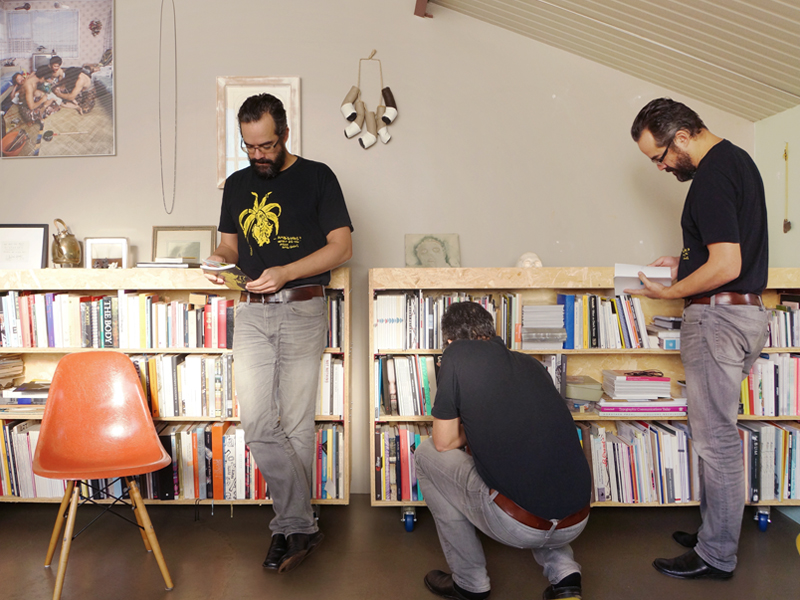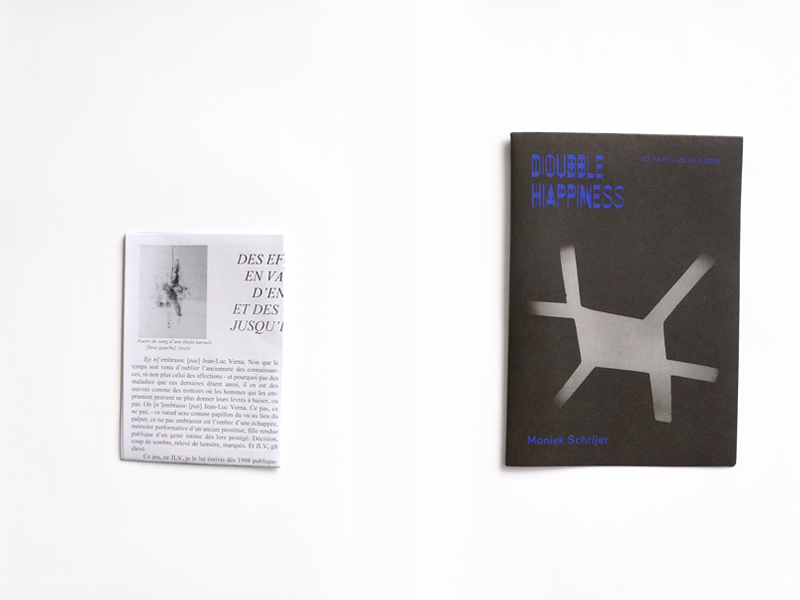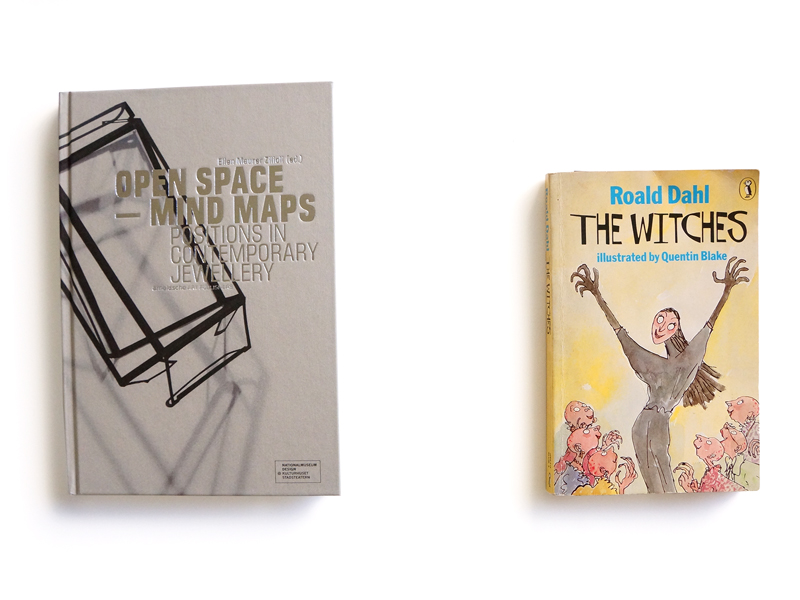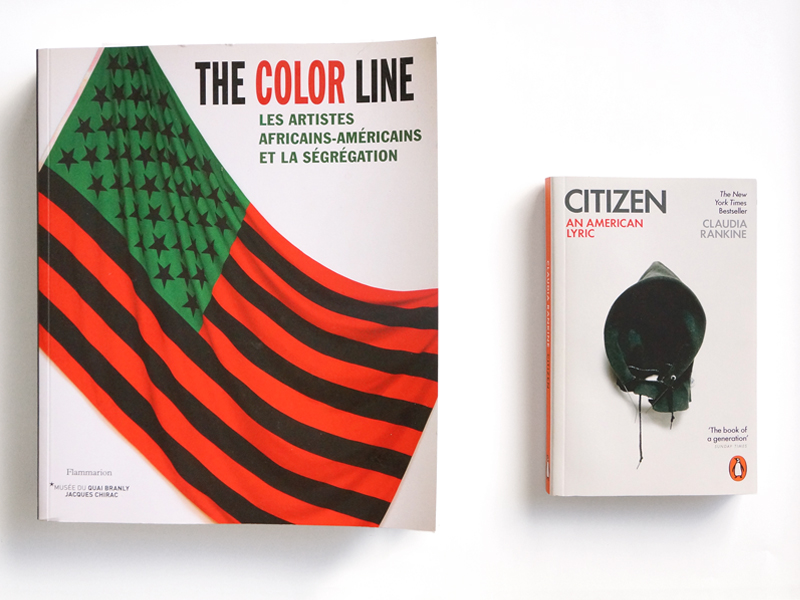
At the end of 2016, Ben Lignel, AJF’s editor for the past four years, will be leaving us. He has had a great run, and we will miss him. Before he goes, I wanted to get his insights and thoughts about what has happened in the contemporary jewelry world from his perspective, and how his thinking has changed in that time. He has given some very thoughtful and insightful responses to my questions. I think you will find them very interesting.
As a parting tribute to what AJF stands for, and to pay homage to its long-standing habit of asking interviewees about recent “reads,” Ben chose to illustrate this interview with all the printed matter he read—or looked at—this month. Thank you, Ben, and wishing you the very best for the future!
Susan Cummins: Ben, what were you doing at the moment you were plucked from your status as an independent artist to serve as editor for AJF four years ago?
Benjamin Lignel: 2013 was an interesting year. I received more attention for my jewelry work than I had previously—I had my first solo show in Paris, at NextLevel, with Kiko Gianocca as guest, and then exhibited a chunk of that exhibition at the Musée des Arts Décoratifs. I had also begun curating jewelry exhibitions a few years prior, and started working on Différence and Répétition, a show that eventually toured to Bergen and Paris, with Fred F. Martin and Jorunn Veiteberg. I loved working on that show, because it allowed the three of us to test one of the interesting contradictions of contemporary craft practice, namely that it is both generic and singular. I was starting to write quite a bit, back then, filling a perceived void in the imaginary ranks of craft theorists.
And then I got a phone call from you, asking if I could recommend someone for the editor position at AJF. Damian Skinner was leaving and, back then, there seemed to be only a handful of possible candidates. You eventually hired me, which meant that over the next few years I would concentrate most of my attention on writing, whether my own or that of others.

After directing traffic on our website for so long, can you reflect on how thinking about art jewelry has changed during that time?
Benjamin Lignel: My own thinking, if I may use it as a benchmark, was radically altered by publishing some 350 articles in the span of four years: I thought, when I began, that I knew a lot about contemporary jewelry practice. And then the more I published, the more I realized how complex and varied the field is. “Contemporary jewelry” or “art jewelry” are weird catchall expressions that play umbrella to practices so different as to seem incompatible. In 2010, my own outlook was that there was more to gain by accommodating variety under a single moniker, the better to “defend” contemporary jewelry practice. That has changed: There is now more to be gained by attending to diversity, and recognizing difference in practices. I’m not interested anymore in playing the chorus line and promoting a discourse on craft-as-endangered-species. At the end of my tenure, I realize that I’ve worked with around 200 different writers, engaging with a field that encompasses hundreds of creative minds. The current challenge is about making space for interesting, critical, and divergent conversations, and looking at jewelry in the context of other creative fields—fashion, design, photography, performance—not so much about “defending” the field at large.
One of your missions has been to nurture young writing talents, while keeping an eye open for interesting new voices. How has writing about jewelry changed over the last four years? What role do you think writing should play in the development of the field? What will its position be in the future?
Benjamin Lignel: Let’s define “writing about jewelry”: A large chunk of the writing devoted to contemporary jewelry is affirmative. It may take the form of press releases or artists’ statements, and consists of a mix of self-promotion and statement of intent. Another large chunk happens online: blogs and Facebook threads, to which I would add Instagram’s and Pinterest’s largely wordless clusters of networked visual information. I think they’re all part of “discourse” and certainly stake positions about the field. (“This is what I like, what I look at, what I want to show you” are part of how we define ourselves as makers, writers, curators, critics.) In sheer quantity and penetration power, these completely outweigh what you and I refer to—quite narrowly—as “jewelry writing”: commissioned pieces, whether reviews, or essays, that provide a critical analysis of the field.

All these types of writing are shaping the way we think about contemporary jewelry, or craft at large. My friend and colleague Namita Wiggers introduced me a short while ago to Pots in Action: This is an extremely popular Instagram feed, created by potter Ayumi Horie, on which people around the globe document the life of clay. Contributions are very attentive to the “situations and environments” of pot-making, pot-selling, and pot-using, to the point that they seem completely devoted to the human context in which objects are made, used, swapped, or taught. I love the platform’s generosity, and the seemingly infinite points of view that it provides on “pots.” I’m seduced by the fact it puts our shared humanity at the service of craft—and in turn posits craft as a sign of that humanity (giving hope that, well, we’re not completely and totally screwed as a species, recent elections notwithstanding). But the “opting-in” model of Pots in Action, like other online platforms, supposes a community with common interests, and a form of complicity. It’s functional, positive, friendly.
Alongside those spaces for sharing, we also need spaces for constructive criticism—like AJF—and constructive dissent—like Critical Craft Forum. My intuition is that the future of jewelry writing lies at the intersection between crowdsourced, commissioned, and academic work, but I’m not sure we’ve found a way to make them intersect fruitfully … yet.
From your perch here at AJF, what words of wisdom—or maybe I should say which groovy words!—would you like to share with your readers about the importance of the work we do here?
Benjamin Lignel: In a thank you note addressed to AJF’s many contributing writers, I listed what I perceive to be *groovy* telltale examples of AJF’s usefulness and influence: seeing a seven-part criticality series quickly become reading-group material; getting emails from readers who “respectfully disagree” with a particular article and cite AJF as the standard by which they judge it; looking at a room full of keen jewelry professionals, knowing that their questions, and the analytical instruments they use, are the better for being regular readers; giving some writers their first paid and published gig and seeing them get commissions on the strength of these.
We are kept on our toes—because our readers are demanding and will often take us to task on what we publish. I have occasionally received angry emails, but I don’t know of a single occurrence when the ensuing conversation has not been useful to define and explain our editorial line.
I occasionally wonder if our readers understand the amount of work that goes into our editorial work, and feel frustrated by the fact that our contribution to the field is so difficult to measure. But then I’ll meet an educator, a maker, or a student who will tell me, “Yeah, I read that. That was really useful.” Although I’ll typically hear that a year after publication, it reminds me why the service we provide is so important.

What were some of the most exciting articles that passed through your hands on their way to our website?
Benjamin Lignel: The criticality series, first. I’m still in awe of the precision and diversity of the points of view that it channeled. Moyra Elliott’s article changed the way I think about craft’s relationship to community, and clarified for me why, ultimately, that community is reluctant to embrace criticism. Suzanne Ramljak’s and Garth Clark’s articles managed to frame critical writers as a bunch of heroic, embattled cultural first-responders: as a vital counter-power to the thumbs-up/troll culture of social media.
Damian Skinner’s review of Otto Künzli’s exhibition continues to stand as a model of critical writing, as does Grace Cochrane’s review of Damian Skinner and Kevin Murray’s Place and Adornment. Grace and Damian are both well informed, balanced, fearless, and intelligent.
I do love a good piece of writing—which doesn’t always mean a piece of criticism. A few articles and reviews stand out because they were so well written: Rutger Emmelkamp on Bielander; Maria Buszek’s iconographical study of the reclining male nude; Timothy Information Limited on Maggie Thatcher’s pearl necklace, Jillian Moore on Glitz, Kellie Riggs on exhibition-making, Suzanne Ramljak on chastity rings, or Monica Gaspar’s riff on Cartier’s “nail” bracelet.
Roseanne Bartley’s experimental encounter with Daniel Kruger’s Necklace stood out, recently, as a form of enquiry that prolongs both his and her practice, which for me makes it very unique and exciting.
Interviews are a weird exercise that requires writers to embrace their subjects while keeping them at arm’s length. A few interviews were particularly thoughtful and eye-opening: Benedikt Fischer with both Dorothea Prühl and Suska Mackert, Matt Lambert with Marjorie Schick, Clotilde Lebas with Sophie Hanagarth.
Deserving a particular mention for the range of her writing for AJF is Liesbeth den Besten: Her author’s page lists no less than 19 pieces, and some—like her review of Dare to Wear—are emblematic of Liesbeth’s thorough and über-informed reporting. Like Kevin Murray, or Damian Skinner, she has been fundamental in shaping AJF’s voice.

We often discussed within the publication committee the balance between “popular” pieces and more “difficult” articles. How did that shape the editorial line?
Ben Lignel: Once every month or so, for the past four years, I’ve had a meeting with you, Rebekah Frank, Sienna Patti, Marthe LeVan, Liesbeth den Besten, and Bella Neyman. This is an extremely privileged situation, which gave us all the opportunity to discuss publications, to assess what worked and what didn’t, and to fine-tune the editorial direction.
As I said earlier, knowing what “worked” is a difficult task: very visual articles—such as the “best of” series—have been hugely popular, but don’t provide much food for thought. Meanwhile, a thoughtful, intelligent review of a complex show, like MAD’s …buried again to carry on growing…, by Marilyn Zapf, requires some effort to read. The former will garner 2,000 page views and be “consumed” in less than two minutes. Longer, “difficult” pieces will keep the attention of 200 readers for more that 20 minutes.
The publication committee always supported the idea that AJF’s many donors and readers will find both types of content useful. And that, in fact, the field needs both eye candy and long analyses to grow. Whilst I know that the publication committee will keep discussing the issue, I think we’ve managed to strike a good balance between the two.
What are you most proud of accomplishing, and what have been your biggest challenges?
Ben Lignel: I take pride in having collaborated with a stupendous cast of authors, and provided what I believe is a multiplicity of thoughtful perspectives on the field, from the point of view of makers, collectors, dealers, curators, historians, critics, and outside commentators. This huge reference library of essays, reviews, and interviews is available for free, forever, to everyone. No one else in our field does that.
The biggest challenge is a matter of perception: Whatever pushback I did receive over the last four years was about AJF being “too American” and “too European” (yes, both). Which I assume is shorthand for saying it’s biased. Given the fact that no less than 53 writers from 16 different countries contributed in 2016, and that neither the US nor Europe respectively account for more than a third of our coverage, I think this is, well, unfounded. But the perception is proving resilient.
You produced three books for AJF—AJF Best of Interviews, Shows and Tales: On Jewelry Exhibition-Making, and, most recently, On and Off: Jewelry in the Wider Cultural Field. Do you think books influence the field in a different way than online content does?
Ben Lignel: Our books function differently from the website because they provide a focused, sustained argument on a single subject, whereas the website has sought to be representative of the field’s diversity. They’re therefore very different objects to put together, and they seem to perform a different function: Shows and Tales became a reference book as soon as it was published, simply because the subject of jewelry exhibition-making had never before been engaged with in book format. It includes quite spectacular bits of research (in particular by Toni Greenbaum, Namita Wiggers, Liesbeth den Besten, Cindi Strauss, and Mònica Gaspar), and so I imagine that current and future jewelry curators will continue to refer to it, until it’s replaced by another book on the subject. I think that Liesbeth den Besten’s On Jewelry, or Damian Skinner’s Contemporary Jewelry in Perspective, enjoy the same sort of position: useful reference books in a sea of monographs.
Similarly, On and Off looks at jewelry in a wider cultural context than any of the (great!) books that tend to be published, every year, on contemporary practice.

Can you give us a list of the established writers we should keep an eye on for intelligent writing in the future? How about a list of young writers?
Ben Lignel: I think that established writers are well known, and so do not need to be listed here. Younger writers—or writers who only recently started writing on jewelry—would include Lizzie Atkins, Céline Browning, Melissa Cameron, Kimberley Chandler, Morgane de Klerk, Siân Hindle, Courtney Kemp, Matt Lambert, Amina Rizwan, Edgar Mosa, and Marilyn Zapf.
Gabriel Craig, Philip Clark, Julie Ewington, André Gali, Stephen Knott, Pravu Mazumdar, Jillian Moore, and Meredith Turnbull are not “new” writers, but I look forward to reading more from them: They all have a deep and distinctive engagement with the field.
You’ll be leaving AJF on the last day of the year. What are your plans?
Ben Lignel: A few projects will keep me busy throughout 2017: I’m advising the Musée d’Art Moderne de la Ville de Paris on MEDUSA, a (huge) jewelry exhibition curated by Anne Dressen. The show will open on May 18, 2017, and seeks to deconstruct popular perceptions of jewelry—from the specific standpoint of an art museum. The show will only close in November, so part of it will coincide with the forthcoming Parcours Bijoux. So the fall will be an exciting time to be in Paris!
I’m also very much involved in a long-term research project on gender and jewelry with Namita Wiggers. Jenni Sorkin – who was on the publication committee at the time – dropped that hot potato of a subject into AJF’s lap two years ago. The original response was to create an AJF book project. The project has shifted, now, to be an independent and extensive research, exhibition, and publication endeavor. Namita and I just did two inspiring series of interviews in San Francisco and Stockholm. I think we’re both still awestruck by the generosity of the artists, academics, collectors, and dealers who gave us their time and shared their stories with us. In February, we will further the project through Critical Craft Forum’s eighth session at College Art Association and interviews in NYC, and then on to interviews in Portland, Paris, Berlin, and more. Two museums have expressed interest in hosting an exhibition on the subject, and we’ll continue work on a publication as well.
On a more regular basis, I lecture at the Nürnberg Akademie der Bildenden Künste, as a guest to Suska Mackert, and will be teaching the master program at Alchimia next year.
Finally, I received a very kind invitation to exhibit at Four, in March. I say “very kind” because Karin Andersson and her partners are giving me an opportunity to turn the pages back to where I was in 2013 (as described at the beginning of this interview): an independent artist, busy making, showing, explaining, and trying again.
This is where I am.

INDEX IMAGE: light work lunch with collaborator Namita Wiggers, Summer 2016, photo: Benjamin Lignel




